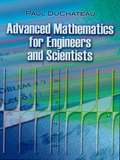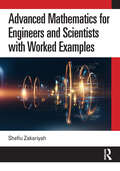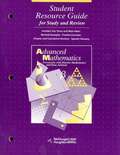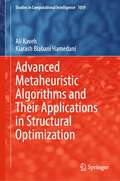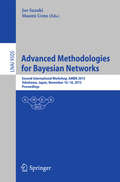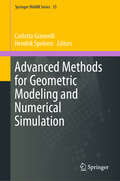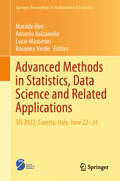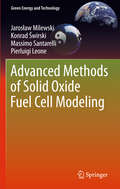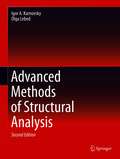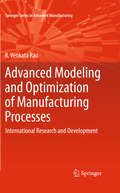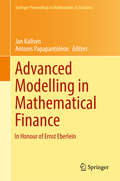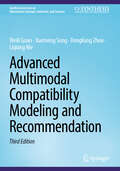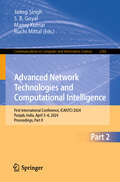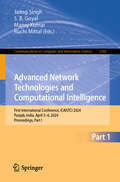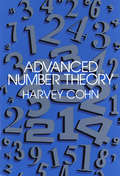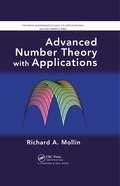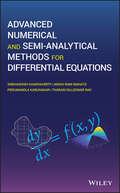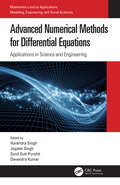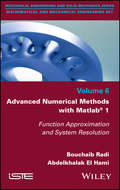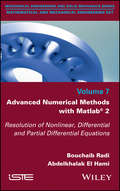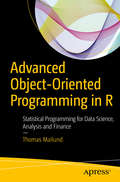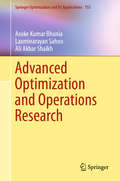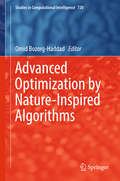- Table View
- List View
Advanced Mathematics for Engineers and Scientists (Dover Books on Mathematics)
by Paul DuchateauThis book can be used as either a primary text or a supplemental reference for courses in applied mathematics. Its core chapters are devoted to linear algebra, calculus, and ordinary differential equations. Additional topics include partial differential equations and approximation methods. Each chapter features an ample selection of solved problems. These problems were chosen to illustrate not only how to solve various algebraic and differential equations but also how to interpret the solutions in order to gain insight into the behavior of the system modeled by the equation. In addition to the worked-out problems, numerous examples and exercises appear throughout the text.
Advanced Mathematics for Engineers and Scientists with Worked Examples
by Shefiu ZakariyahAdvanced Mathematics for Engineers and Scientists with Worked Examples covers core to advanced topics in mathematics required for science and engineering disciplines. It is primarily designed to provide a comprehensive, straightforward and step-by-step presentation of mathematical concepts to engineers, scientists and general readers. It moves from simple to challenging areas, with carefully tailored worked examples also of different degrees of challenge. Mathematical concepts are deliberately linked with appropriate engineering applications to reinforce their value and are aligned with topics taught in major overseas curriculums.This book is written primarily for students at levels 3 and 4 (typically in the early stages of a degree in engineering or a related discipline) or for those undertaking foundation, access, Higher National Certificate (HND), International Foundation Year (IFY), and International Year One (IYO) courses with math modules. It is organised into four main parts:Part I: TrigonometryPart II: Advanced MathematicsPart III: Matrices and VectorsPart IV: CalculusEach of the above four parts is divided into two or more chapters, and each chapter can be used as a stand-alone guide with no prior knowledge assumed. Additional exercises and resources for each chapter can be found online. To access this supplementary content, please go to www.dszak.com.
Advanced Mathematics Precalculus With Discrete Mathematics And Data Analysis
by Houghton Mifflin Company StaffThe Student Resource Guide for Study and Review is a set of lessons designed to help students study and review effectively. This guide is intended to be used in conjunction with Advanced Mathematics, Precalculus with Discrete Mathematics and Data Analysis.
Advanced Metaheuristic Algorithms and Their Applications in Structural Optimization (Studies in Computational Intelligence #1059)
by Ali Kaveh Kiarash Biabani HamedaniThe main purpose of the present book is to develop a general framework for population-based metaheuristics based on some basic concepts of set theory. The idea of the framework is to divide the population of individuals into subpopulations of identical sizes. Therefore, in each iteration of the search process, different subpopulations explore the search space independently but simultaneously. The framework aims to provide a suitable balance between exploration and exploitation during the search process. A few chapters containing algorithm-specific modifications of some state-of-the-art metaheuristics are also included to further enrich the book. The present book is addressed to those scientists, engineers, and students who wish to explore the potentials of newly developed metaheuristics. The proposed metaheuristics are not only applicable to structural optimization problems but can also be used for other engineering optimization applications. The book is likely to be of interest to a wide range of engineers and students who deal with engineering optimization problems.
Advanced Methodologies for Bayesian Networks: Second International Workshop, AMBN 2015, Yokohama, Japan, November 16-18, 2015. Proceedings (Lecture Notes in Computer Science #9505)
by Joe Suzuki Maomi UenoThis volume constitutes the refereed proceedings of the Second International Workshop on Advanced Methodologies for Bayesian Networks, AMBN 2015, held in Yokohama, Japan, in November 2015. The 18 revised full papers and 6 invited abstracts presented were carefully reviewed and selected from numerous submissions. In the International Workshop on Advanced Methodologies for Bayesian Networks (AMBN), the researchers explore methodologies for enhancing the effectiveness of graphical models including modeling, reasoning, model selection, logic-probability relations, and causality. The exploration of methodologies is complemented discussions of practical considerations for applying graphical models in real world settings, covering concerns like scalability, incremental learning, parallelization, and so on.
Advanced Methods for Geometric Modeling and Numerical Simulation (Springer INdAM Series #35)
by Carlotta Giannelli Hendrik SpeleersThis book gathers selected contributions presented at the INdAM Workshop “DREAMS”, held in Rome, Italy on January 22−26, 2018. Addressing cutting-edge research topics and advances in computer aided geometric design and isogeometric analysis, it covers distinguishing curve/surface constructions and spline models, with a special focus on emerging adaptive spline constructions, fundamental spline theory and related algorithms, as well as various aspects of isogeometric methods, e.g. efficient quadrature rules and spectral analysis for isogeometric B-spline discretizations. Applications in finite element and boundary element methods are also discussed. Given its scope, the book will be of interest to both researchers and graduate students working in these areas.
Advanced Methods in Statistics, Data Science and Related Applications: SIS 2022, Caserta, Italy, June 22–24 (Springer Proceedings in Mathematics & Statistics #467)
by Matilde Bini Antonio Balzanella Lucio Masserini Rosanna VerdeThis book contains a selection of the improved contributions submitted by participants at the conference of the Italian Statistical Society - SIS 2022 held in Caserta 22-24 June 2022. The scientific community of Italian statistics, which gathers around the SIS, is paying particular attention to the development of statistical techniques increasingly oriented toward the processing of large data, mainly, of complex data. The main goal is to provide the analysis of the data and the interpretability of the obtained results, with a view to decision support and the reliability of the data outcomes. The aim of this volume is to show some of the most relevant contributions of statistical and data analysis methods in preserving the quality of the information to be processed, especially when it comes from different, often non-official sources; as well as in the extraction of knowledge from complex data (textual, network, unstructured and multivalue) and in the explicability of results. Data Science today represents a broad domain of knowledge development from data, where statistical and data analysis methods can make an important contribution in the different domains where data management and processing are required. This volume is addressed to researchers but also to Ph.D. and MSc students in the field of Statistics and Data Science to acquaint them with some of the most recent developments towards which statistical research is orienting, in prevalence in Italy.
Advanced Methods in the Fractional Calculus of Variations (SpringerBriefs in Applied Sciences and Technology)
by Agnieszka B. Malinowska Tatiana Odzijewicz Delfim F.M. TorresThis brief presents a general unifying perspective on the fractional calculus. It brings together results of several recent approaches in generalizing the least action principle and the Euler-Lagrange equations to include fractional derivatives. The dependence of Lagrangians on generalized fractional operators as well as on classical derivatives is considered along with still more general problems in which integer-order integrals are replaced by fractional integrals. General theorems are obtained for several types of variational problems for which recent results developed in the literature can be obtained as special cases. In particular, the authors offer necessary optimality conditions of Euler-Lagrange type for the fundamental and isoperimetric problems, transversality conditions, and Noether symmetry theorems. The existence of solutions is demonstrated under Tonelli type conditions. The results are used to prove the existence of eigenvalues and corresponding orthogonal eigenfunctions of fractional Sturm-Liouville problems. Advanced Methods in the Fractional Calculus of Variations is a self-contained text which will be useful for graduate students wishing to learn about fractional-order systems. The detailed explanations will interest researchers with backgrounds in applied mathematics, control and optimization as well as in certain areas of physics and engineering.
Advanced Methods of Solid Oxide Fuel Cell Modeling (Green Energy and Technology)
by Jarosław Milewski Pierluigi Leone Massimo Santarelli Konrad ŚwirskiFuel cells are widely regarded as the future of the power and transportation industries. Intensive research in this area now requires new methods of fuel cell operation modeling and cell design. Typical mathematical models are based on the physical process description of fuel cells and require a detailed knowledge of the microscopic properties that govern both chemical and electrochemical reactions. Advanced Methods of Solid Oxide Fuel Cell Modeling proposes the alternative methodology of generalized artificial neural networks (ANN) solid oxide fuel cell (SOFC) modeling. Advanced Methods of Solid Oxide Fuel Cell Modeling provides a comprehensive description of modern fuel cell theory and a guide to the mathematical modeling of SOFCs, with particular emphasis on the use of ANNs. Up to now, most of the equations involved in SOFC models have required the addition of numerous factors that are difficult to determine. The artificial neural network (ANN) can be applied to simulate an object's behavior without an algorithmic solution, merely by utilizing available experimental data. The ANN methodology discussed in Advanced Methods of Solid Oxide Fuel Cell Modeling can be used by both researchers and professionals to optimize SOFC design. Readers will have access to detailed material on universal fuel cell modeling and design process optimization, and will also be able to discover comprehensive information on fuel cells and artificial intelligence theory.
Advanced Methods of Structural Analysis
by Igor A. Karnovsky Olga LebedThis revised and significantly expanded edition contains a rigorous examination of key concepts, new chapters and discussions within existing chapters, and added reference materials in the appendix, while retaining its classroom-tested approach to helping readers navigate through the deep ideas, vast collection of the fundamental methods of structural analysis. The authors show how to undertake the numerous analytical methods used in structural analysis by focusing on the principal concepts, detailed procedures and results, as well as taking into account the advantages and disadvantages of each method and sphere of their effective application. The end result is a guide to mastering the many intricacies of the range of methods of structural analysis. The book differentiates itself by focusing on extended analysis of beams, plane and spatial trusses, frames, arches, cables and combined structures; extensive application of influence lines for analysis of structures; simple and effective procedures for computation of deflections; introduction to plastic analysis, stability, and free and forced vibration analysis, as well as some special topics. Ten years ago, Professor Igor A. Karnovsky and Olga Lebed crafted a must-read book. Now fully updated, expanded, and titled Advanced Methods of Structural Analysis (Strength, Stability, Vibration), the book is ideal for instructors, civil and structural engineers, as well as researches and graduate and post graduate students with an interest in perfecting structural analysis.
Advanced Modeling and Optimization of Manufacturing Processes: International Research and Development (Springer Series in Advanced Manufacturing)
by R. Venkata RaoAdvanced Modeling and Optimization of Manufacturing Processes presents a comprehensive review of the latest international research and development trends in the modeling and optimization of manufacturing processes, with a focus on machining. It uses examples of various manufacturing processes to demonstrate advanced modeling and optimization techniques. Both basic and advanced concepts are presented for various manufacturing processes, mathematical models, traditional and non-traditional optimization techniques, and real case studies. The results of the application of the proposed methods are also covered and the book highlights the most useful modeling and optimization strategies for achieving best process performance. In addition to covering the advanced modeling, optimization and environmental aspects of machining processes, Advanced Modeling and Optimization of Manufacturing Processes also covers the latest technological advances, including rapid prototyping and tooling, micromachining, and nano-finishing. Advanced Modeling and Optimization of Manufacturing Processes is written for designers and manufacturing engineers who are responsible for the technical aspects of product realization, as it presents new models and optimization techniques to make their work easier, more efficient, and more effective. It is also a useful text for practitioners, researchers, and advanced students in mechanical, industrial, and manufacturing engineering.
Advanced Modelling in Mathematical Finance: In Honour of Ernst Eberlein (Springer Proceedings in Mathematics & Statistics #189)
by Jan Kallsen Antonis PapapantoleonThis Festschrift resulted from a workshop on "Advanced Modelling in Mathematical Finance" held in honour of Ernst Eberlein's 70th birthday, from 20 to 22 May 2015 in Kiel, Germany. It includes contributions by several invited speakers at the workshop, including several of Ernst Eberlein's long-standing collaborators and former students. Advanced mathematical techniques play an ever-increasing role in modern quantitative finance. Written by leading experts from academia and financial practice, this book offers state-of-the-art papers on the application of jump processes in mathematical finance, on term-structure modelling, and on statistical aspects of financial modelling. It is aimed at graduate students and researchers interested in mathematical finance, as well as practitioners wishing to learn about the latest developments.
Advanced Multimodal Compatibility Modeling and Recommendation (Synthesis Lectures on Information Concepts, Retrieval, and Services)
by Weili Guan Xuemeng Song Dongliang Zhou Liqiang NieThis Third Edition sheds light on state-of-the-art theories and practices in multimodal compatibility modeling and recommendation, offering comprehensive insights into this evolving field. This topic, and fashion compatibility modeling in particular, has garnered increasing research attention in recent years due to the significant economic impact of e-commerce. Building upon recent research and the prior edition, the authors present a series of graph-learning based multimodal compatibility modeling schemes, all of which have been proven to be effective over several public real-world datasets. This book introduces a number of advanced multimodal compatibility modeling and recommendation methods, including category-guided multimodal compatibility modeling and try-on-guided multimodal compatibility modeling. The authors also provide comprehensive solutions, including correlation-oriented graph learning, modality-oriented graph learning, unsupervised disentangled graph learning, partially supervised disentangled graph learning, and metapath-guided heterogeneous graph learning.
Advanced Network Technologies and Computational Intelligence: First International Conference, ICANTCI 2024, Punjab, India, April 5–6, 2024, Proceedings, Part II (Communications in Computer and Information Science #2383)
by Manoj Kumar S. B. Goyal Jaiteg Singh Ruchi MittalThis two-volume set, CCIS 2382 and CCIS 2383, constitutes the refereed proceedings of the First International Conference on Advanced Network Technologies and Computational Intelligence, ICANTCI 2024, held in Punjab, India, during April 5-6, 2024. The 38 full papers and 6 short papers included in this book were carefully reviewed and selected from 153 submissions. The papers are organized in the following topical sections: Part I: Advanced Network Technologies; Computational Intelligence. Part II: Computational Intelligence; Computer Technology Trends.
Advanced Network Technologies and Computational Intelligence: First International Conference, ICANTCI 2024, Punjab, India, April 5–6, 2024, Proceedings, Part I (Communications in Computer and Information Science #2382)
by Manoj Kumar S. B. Goyal Jaiteg Singh Ruchi MittalThis two-volume set, CCIS 2382 and CCIS 2383, constitutes the refereed proceedings of the First International Conference on Advanced Network Technologies and Computational Intelligence, ICANTCI 2024, held in Punjab, India, during April 5-6, 2024. The 38 full papers and 6 short papers included in this book were carefully reviewed and selected from 153 submissions. The papers are organized in the following topical sections: Part I: Advanced Network Technologies; Computational Intelligence. Part II: Computational Intelligence; Computer Technology Trends.
Advanced Number Theory
by Harvey Cohn"A very stimulating book ... in a class by itself." -- American MathematicalMonthlyAdvanced students, mathematicians and number theorists will welcome this stimulating treatment of advanced number theory, which approaches the complex topic of algebraic number theory from a historical standpoint, taking pains to show the reader how concepts, definitions and theories have evolved during the last two centuries. Moreover, the book abounds with numerical examples and more concrete, specific theorems than are found in most contemporary treatments of the subject.The book is divided into three parts. Part I is concerned with background material -- a synopsis of elementary number theory (including quadratic congruences and the Jacobi symbol), characters of residue class groups via the structure theorem for finite abelian groups, first notions of integral domains, modules and lattices, and such basis theorems as Kronecker's Basis Theorem for Abelian Groups.Part II discusses ideal theory in quadratic fields, with chapters on unique factorization and units, unique factorization into ideals, norms and ideal classes (in particular, Minkowski's theorem), and class structure in quadratic fields. Applications of this material are made in Part III to class number formulas and primes in arithmetic progression, quadratic reciprocity in the rational domain and the relationship between quadratic forms and ideals, including the theory of composition, orders and genera. In a final concluding survey of more recent developments, Dr. Cohn takes up Cyclotomic Fields and Gaussian Sums, Class Fields and Global and Local Viewpoints.In addition to numerous helpful diagrams and tables throughout the text, appendices, and an annotated bibliography, Advanced Number Theory also includes over 200 problems specially designed to stimulate the spirit of experimentation which has traditionally ruled number theory.
Advanced Number Theory with Applications (Discrete Mathematics and Its Applications)
by Richard A. MollinExploring one of the most dynamic areas of mathematics, Advanced Number Theory with Applications covers a wide range of algebraic, analytic, combinatorial, cryptographic, and geometric aspects of number theory. Written by a recognized leader in algebra and number theory, the book includes a page reference for every citing in the bibliography and mo
Advanced Numerical and Semi-Analytical Methods for Differential Equations
by Snehashish Chakraverty Nisha Mahato Perumandla Karunakar Tharasi Dilleswar RaoExamines numerical and semi-analytical methods for differential equations that can be used for solving practical ODEs and PDEs This student-friendly book deals with various approaches for solving differential equations numerically or semi-analytically depending on the type of equations and offers simple example problems to help readers along. Featuring both traditional and recent methods, Advanced Numerical and Semi Analytical Methods for Differential Equations begins with a review of basic numerical methods. It then looks at Laplace, Fourier, and weighted residual methods for solving differential equations. A new challenging method of Boundary Characteristics Orthogonal Polynomials (BCOPs) is introduced next. The book then discusses Finite Difference Method (FDM), Finite Element Method (FEM), Finite Volume Method (FVM), and Boundary Element Method (BEM). Following that, analytical/semi analytic methods like Akbari Ganji's Method (AGM) and Exp-function are used to solve nonlinear differential equations. Nonlinear differential equations using semi-analytical methods are also addressed, namely Adomian Decomposition Method (ADM), Homotopy Perturbation Method (HPM), Variational Iteration Method (VIM), and Homotopy Analysis Method (HAM). Other topics covered include: emerging areas of research related to the solution of differential equations based on differential quadrature and wavelet approach; combined and hybrid methods for solving differential equations; as well as an overview of fractal differential equations. Further, uncertainty in term of intervals and fuzzy numbers have also been included, along with the interval finite element method. This book: Discusses various methods for solving linear and nonlinear ODEs and PDEs Covers basic numerical techniques for solving differential equations along with various discretization methods Investigates nonlinear differential equations using semi-analytical methods Examines differential equations in an uncertain environment Includes a new scenario in which uncertainty (in term of intervals and fuzzy numbers) has been included in differential equations Contains solved example problems, as well as some unsolved problems for self-validation of the topics covered Advanced Numerical and Semi Analytical Methods for Differential Equations is an excellent text for graduate as well as post graduate students and researchers studying various methods for solving differential equations, numerically and semi-analytically.
Advanced Numerical Methods for Differential Equations: Applications in Science and Engineering (Mathematics and its Applications)
by Harendra SinghMathematical models are used to convert real-life problems using mathematical concepts and language. These models are governed by differential equations whose solutions make it easy to understand real-life problems and can be applied to engineering and science disciplines. This book presents numerical methods for solving various mathematical models. This book offers real-life applications, includes research problems on numerical treatment, and shows how to develop the numerical methods for solving problems. The book also covers theory and applications in engineering and science. Engineers, mathematicians, scientists, and researchers working on real-life mathematical problems will find this book useful.
Advanced Numerical Methods with Matlab 1: Function Approximation and System Resolution
by Bouchaib Radi Abdelkhalak El HamiMost physical problems can be written in the form of mathematical equations (differential, integral, etc.). Mathematicians have always sought to find analytical solutions to the equations encountered in the different sciences of the engineer (mechanics, physics, biology, etc.). These equations are sometimes complicated and much effort is required to simplify them. In the middle of the 20th century, the arrival of the first computers gave birth to new methods of resolution that will be described by numerical methods. They allow solving numerically as precisely as possible the equations encountered (resulting from the modeling of course) and to approach the solution of the problems posed. The approximate solution is usually computed on a computer by means of a suitable algorithm. The objective of this book is to introduce and study the basic numerical methods and those advanced to be able to do scientific computation. The latter refers to the implementation of approaches adapted to the treatment of a scientific problem arising from physics (meteorology, pollution, etc.) or engineering (structural mechanics, fluid mechanics, signal processing, etc.) .
Advanced Numerical Methods with Matlab 2: Resolution of Nonlinear, Differential and Partial Differential Equations
by Bouchaib Radi Abdelkhalak El HamiThe purpose of this book is to introduce and study numerical methods basic and advanced ones for scientific computing. This last refers to the implementation of appropriate approaches to the treatment of a scientific problem arising from physics (meteorology, pollution, etc.) or of engineering (mechanics of structures, mechanics of fluids, treatment signal, etc.). Each chapter of this book recalls the essence of the different methods resolution and presents several applications in the field of engineering as well as programs developed under Matlab software.
Advanced Numerical Simulation Methods: From CAD Data Directly to Simulation Results
by Gernot BeerThis entertaining introduction to advanced numerical modeling aims to lead the reader on a journey towards theholy grail of numerical simulation, i.e. one without the requirement of mesh generation, that takes data directly from CAD programs. This hands-on book emphasizes implementation and examples of programming in a higher level language are given. Written for users of simulation software, so they can understand the benefits of this new technology and demand progress from a somewhat conservative industry. Written for software developers, so they can see that this is a technology with a big future and written for researchers, in the hope that it will attract more people to work in this field.
Advanced Object-Oriented Programming in R: Statistical Programming for Data Science, Analysis and Finance
by Thomas MailundLearn how to write object-oriented programs in R and how to construct classes and class hierarchies in the three object-oriented systems available in R. This book gives an introduction to object-oriented programming in the R programming language and shows you how to use and apply R in an object-oriented manner. You will then be able to use this powerful programming style in your own statistical programming projects to write flexible and extendable software. After reading Advanced Object-Oriented Programming in R, you'll come away with a practical project that you can reuse in your own analytics coding endeavors. You'll then be able to visualize your data as objects that have state and then manipulate those objects with polymorphic or generic methods. Your projects will benefit from the high degree of flexibility provided by polymorphism, where the choice of concrete method to execute depends on the type of data being manipulated. What You'll Learn Define and use classes and generic functions using R Work with the R class hierarchies Benefit from implementation reuse Handle operator overloading Apply the S4 and R6 classes Who This Book Is For Experienced programmers and for those with at least some prior experience with R programming language.
Advanced Optimization and Operations Research (Springer Optimization and Its Applications #153)
by Asoke Kumar Bhunia Laxminarayan Sahoo Ali Akbar ShaikhThis textbook provides students with fundamentals and advanced concepts in optimization and operations research. It gives an overview of the historical perspective of operations research and explains its principal characteristics, tools, and applications. The wide range of topics covered includes convex and concave functions, simplex methods, post optimality analysis of linear programming problems, constrained and unconstrained optimization, game theory, queueing theory, and related topics. The text also elaborates on project management, including the importance of critical path analysis, PERT and CPM techniques. This textbook is ideal for any discipline with one or more courses in optimization and operations research; it may also provide a solid reference for researchers and practitioners in operations research.
Advanced Optimization by Nature-Inspired Algorithms (Studies in Computational Intelligence #720)
by Omid Bozorg-HaddadThis book, compiles, presents, and explains the most important meta-heuristic and evolutionary optimization algorithms whose successful performance has been proven in different fields of engineering, and it includes application of these algorithms to important engineering optimization problems. In addition, this book guides readers to studies that have implemented these algorithms by providing a literature review on developments and applications of each algorithm. This book is intended for students, but can be used by researchers and professionals in the area of engineering optimization.
